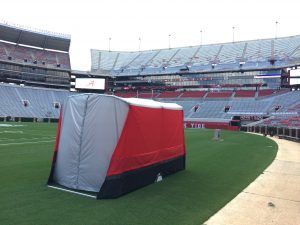
TUSCALOOSA, Ala. — A collapsible tent designed to limit distractions during medical evaluations while providing better privacy for student athletes at The University of Alabama has been introduced this football season.
The tent resulted from a collaboration between Crimson Tide Athletics and UA’s College of Engineering. A provisional patent is filed for the innovative design developed by Jeff Allen, director of sports medicine at UA, and four senior mechanical engineering students.
The Office for Technology Transfer within the UA Office of the Vice President for Research and Economic Development is assisting in protecting and promoting the intellectual property covered in the pending patent.
The tent can be set up on any sideline, and it does not block the view of fans watching the game, Allen said. Most of the game, the tent is collapsed onto the ground, but if an injured player needs an evaluation by the medical staff, it quickly expands over the examination table.
So far, the Crimson Tide football team has used the tent at every game, home and away, except the first game of the season.
“That first 10 minutes of an evaluation of an injury is critical, and that’s usually done on the sideline,” Allen said. “The tent provides an environment free from distractions so that we can improve the level of medical care.”
The tent also provides more privacy for student athletes and medical staff where injured players are traditionally evaluated in view of fans, media and opposing teams, said Dr. E. Lyle Cain Jr., Crimson Tide team physician with Andrews Sports Medicine & Orthopaedic Center in Birmingham.
“The tent is great for patient privacy and confidentiality,” he said. “Often times, the media will report an injury before we have had the chance to notify the family or come up with a treatment plan, so it is a big advantage to examine an athlete in a more private setting.”
The tent creates a less intense atmosphere for doctor and patient, Cain said.
“It makes it like our own little exam room,” he said.
The tent can mean a player does not have to leave the sideline for an evaluation if it is not necessary, Allen said. Still, the tent will likely not be taken onto the field, meaning more serious injuries will still require a player to be taken from the field of play directly to the locker room for evaluation, Allen said.
Allen had the idea for a tent, and he asked Dr. Charles L. Karr, dean of the UA College of Engineering, if he could help. Karr gave the task to design and fabricate the tent to four students in mechanical engineering, who used the tent as their senior design project.
The students are Jared Cassity, of Tuscaloosa; Christian Parris, of Birmingham; Jared Porteous, of Tuscaloosa; and Patrick Powell, of Pelham. Dr. Beth Todd, associate professor of mechanical engineering, was the group’s adviser for the project.
Most tents of this size, such as the commercially-available tailgate tents that dot the Quad on game days, take more than one person to raise, and setting up and taking down is a lengthy process, said Powell, project leader. Commercially-available tents also require guidelines to secure them to the ground.
“The challenge was to deliver the most working space while maintaining a small footprint, develop a system that could be quickly deployed by a single person, and be portable enough to travel with the team for road games,” said Powell. “Once in position, our tent can be raised in less than 10 seconds.”
The tent developed by the students and Allen connects the structure of the tent to a central hub. When raised, the structure fans over the exam table. The exam table secures the structure to the ground and allows the tent be used on grass, artificial turf or concrete without the use of guidelines, Powell said.
“This design allows the tent to fan out from a small footprint into a structure twice as long and fully enclosed,” he said.
The material the students selected had to be light, but strong enough to support the structure and withstand the varying weather conditions, Powell said. The synthetic fabrics chosen allow for ventilation. Furthermore, the light-grey roof is transparent enough to conduct an exam without the need for lights, he said.
Every part of the tent that touches the ground is covered with heavy-grade ballistic nylon to protect from wear and tear from the ground and players’ footwear. The doors are sectioned and clasp together with magnets.
Altec Industries, of Birmingham, donated the manufactured components for the tent, and a custom seamstress, Elizabeth Powell, stitched the fabrics. CAVCO, of Childersburg, donated the supplies for the prototype.
Contact
Adam Jones, UA media relations 205/348-6444, acjones12@eng.ua.edu; Josh Maxson, director of Football Communications, 205/348-3631, jmaxson@ia.ua.edu